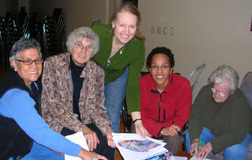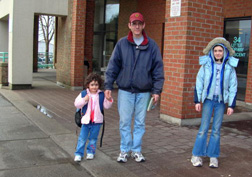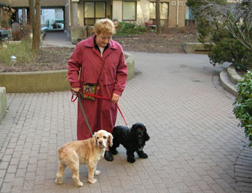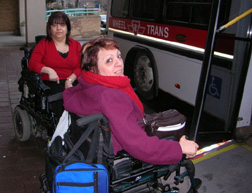By Marlene Ritchie –
Twenty years ago the first residents moved into Windward Cooperative Homes situated at 34 Little Norway Crescent.

Windward committee members plan Windward celebration: Elina Carrillo, Corrie Galloway, Tina Persich, Musonda Kidd, Rita Murphy.
Planning for this co-op began soon after 1981 when The Harbroufront Corporation proposed that a co-op to be built on the west side of Bathurst Quay Park (now Little Norway Park). Lantana, a nonprofit housing resource group that had experience with church sponsored housing and facilities for people with disabilities, the Canadian Paraplegic Association, The Bathurst Co-ops Neighbourhood Committee of local citizens, an architect and a contractor came forward. Shirley Forde, who still lives at Windward, served on the planning committee addressing such considerations as soil contamination, schools, recreation, transportation, parking, and lighting.
Windward is the first fully-accessible co-op in Toronto. The facilities accommodate people with or without disabilities. people of all ages, incomes and ethnic backgrounds who live as a self-governing community.

Robert Strizic of Windward walks daughters Madison and Alexandra to school.
Before the residence was completed, members including Shirley Forde and Derek and Patty Smith went about town interviewing applicants. Cornelia Persich was one of the interviewees. She remembers the repeated delays, packing and than unpacking until she moved on January 1, ’87. Derek and Patty Smith and their sons age 8 and 12 delivered their furniture on December l, 1986 but had to live in temporary quarters until January. “It was like moving into a resort,” Patty said. “Our balcony looked out to the lake.” Most of the early residents mention the noise and confusion caused by so many construction workers. Lena DiCarlo’s bathroom flooded and she lived out of boxes for three months. Elina Carvillo, a widow, and her two daughters moved into Windward on a snowy New Year’s Day, 1987. She had come to Canada from Chile as a political refugee in 1975. “We could go to Italy, Sweden, Israel or Canada. I told my husband, I chose Canada. Amnesty International arranged everything.” Later, after her husband died, one of the architects suggested Windward. “There was no water or electricity. No panic,” she said smiling. “I had to go to Arcadia (Co-op) for water. I am happy here. I have everything, like people, good transportation.”

Doreen Albrecht of Windward takes Chelsey and Truffle for a walk.
Early residents describe the pot-luck dinners. Linda Thomas said her daughters, Amanda and Bridget Ward and Josie Wheatley called themselves “The Pussy Cats” and made up dance routines. Walter Augustowich talked about those parties and working together on committees. “People pulled together. We met volunteering and became friends.”
One man, who needs care-giver assistance, described how the truck delivered his furniture and his caregivers (employed by the forerunner of PACE, an organization funded through the Long Term Care Division of the provincial Ministry of Health) were on hand immediately.
Windward Co-operative Homes Inc. was developed under the National Housing Act of 1973 and amended in 1978 which provided direct Federal funding and loan guarantees though Canada Mortgage and Housing Corporation. At first CMHC guaranteed a mortgage loan from a bank, but presently CMHC holds the Windward mortgage and supplies grants. One stipulation is that units at Windward be available for people with disabilities and another is that Federal funds be applied as subsidies to low income families. The mortgage renewal formula is such that the amount of Federal money for subsidy diminishes as the mortgage is paid down and a new proposed formula will also mean less Federal money. To meet the funding shortfall, residents contribute to an internal subsidy pool. When finances permit, a family’s subsidy stops. Most households pay market rent which is based on budgetary requirements.

Linda De Carlo and Rose Mortelli of Windward take Wheeltrans to work.
“Co-ops work. They are successful,” one long-term resident said. “Everyone chooses to live like good neighbours. There’s a community feeling, a little village in one building.” When asked to describe the co-op strengths and weaknesses he said,” A strength is that we are run by volunteers, ordinary people meeting the needs of people of diversity. A weakness is that ordinary people are running a multimillion dollar business. There are inefficiencies and mistakes. There has been a feeling of security. I feel at home, but now there is uncertainty about subsidy.”
In 1987 Windward was presented with an Accessibility Award by the Mayor, Art Eggleton. Since 1999 the co-op has won six Garden of Distinction Awards, one Flower award and one Newsletter Award, the work of two of the member committees. .
Rose Maretlli summed up the feeling shared by many residents. “People of different backgrounds have integrated to form a community. I feel at home.” Windward celebrates on May 26 from 2:00 to 4:00 p.m. A new generation of The Pussy Cats will perform.
 TheBulletin.ca Journal of Downtown Toronto
TheBulletin.ca Journal of Downtown Toronto

